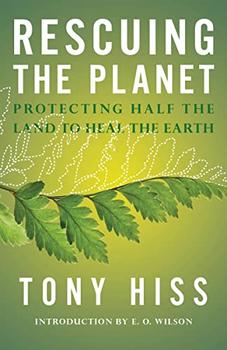Summary | Excerpt | Reviews | Beyond the Book | Readalikes | Genres & Themes | Author Bio

Critics' Opinion:
Readers' Opinion:
First Published:
Mar 2021, 320 pages
Paperback:
Mar 2022, 320 pages
 Book Reviewed by:
Book Reviewed by:
Norah Piehl
Buy This Book
Getting to Half
On a cold, buckety boat ride early one morning near the top of North America, through a forest that looked endless and only kept on getting bigger, I got to thinking that maybe Henry David Thoreau was only half right when it came to his famous and still-ringing cry that "in Wildness is the preservation of the World." Yes, wildness is the answer, but people are missing. Given the state of the planet, if Thoreau were around today, I imagine he'd go the next step and say that "in the People of the Wild is the preservation of the World." Because it is going to take a lot of people to preserve what's still wild, to restore what was once wilder, and to remedy a great calamity in the world.
As a direct result of humanity's destructive actions on the landscape, 1 million species of plants and animals are likely to go extinct, many within the next few decades. A 2019 global assessment, 1,500 pages long, compiled over three years by 145 scientists from fifty countries, makes clear that this mining and undermining of the natural world imperils a millionth-and-first species as well: us. We are "eroding the very foundations of our economies, livelihoods, food security, health and quality of life worldwide," the lead scientist said, leaving only a "very limited" time to turn things around. This deepening emergency, the biodiversity or biocide crisis, was—in pre-COVID-19 days—sometimes referred to as the other environmental crisis, to distinguish it from global warming, the damage done to the air, the water, and the climate.
This book is about a way to stave off the mass extinction crisis by keeping life alive.
The idea is to protect far more natural land than any country or continent has in history. According to the World Bank, North America is less than 15 percent protected; the goal is 50 percent over the next thirty years (50 by '50). This may sound unimaginable, preposterous, impossible—in a word, outlandish (literally). It took 150 years after setting up Yellowstone, the world's first national park, to protect almost 15 percent of the continent, and the challenge now is to work at a pace at least twelve times faster.
Though this plan of action is wildly ambitious, I realized on that boat in Canada's Northwest Territories, and elsewhere on other travels in North America, that it is not only doable but is already being done as individuals and groups take it up quietly, bit by bit, in larger and smaller pieces. These people are building on a century-long history of 50 by '50 thinking and are adopting many different approaches—lots of heroes here, many of whom you will meet in these pages, and an upbeat spirit I've had the pleasure to encounter again and again. Here in North America there's still room to spare, and 50 by '50 can move ahead without crowding or displacing or confining anybody because human activities (cities, suburbs, farms, mines, and all the rest) so far account for less than 40 percent of the continent.
At heart it comes down to how to share the earth with other species, and how much of the landscape not to change.
According to a calculation by E. O. Wilson, America's foremost biologist, protecting 15 percent of the land only guarantees the survival of a quarter of the species with which we now share the earth. But push that figure up to 50 percent of land and sea, and up to nine-tenths of species will survive. How many species are there? Estimates vary tremendously, from 8.7 million species big enough for us to see, and up to 2 billion or even 1 trillion when you include microspecies, the tiny things we can't see, bacteria and fungi—and far more still if viruses are also counted.
Warning: 50 by '50 is by necessity a bittersweet project. It's a situation where "happily ever after" has to have an asterisk after it. Because of habitat devastation and global warming, some species will be lost no matter what. But the sooner progress can be made, the less regret there will be to carry forward.
Excerpted from Rescuing the Planet by Tony Hiss. Copyright © 2021 by Tony Hiss. All rights reserved. No part of this excerpt may be reproduced or reprinted without permission in writing from the publisher.





The Flower Sisters
by Michelle Collins Anderson
From the new Fannie Flagg of the Ozarks, a richly-woven story of family, forgiveness, and reinvention.

The House on Biscayne Bay
by Chanel Cleeton
As death stalks a gothic mansion in Miami, the lives of two women intertwine as the past and present collide.

The Funeral Cryer by Wenyan Lu
Debut novelist Wenyan Lu brings us this witty yet profound story about one woman's midlife reawakening in contemporary rural China.
Your guide toexceptional books
BookBrowse seeks out and recommends the best in contemporary fiction and nonfiction—books that not only engage and entertain but also deepen our understanding of ourselves and the world around us.